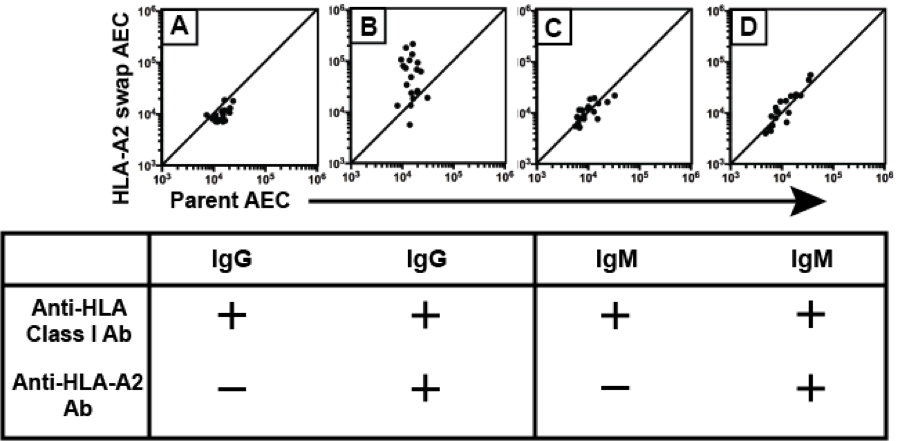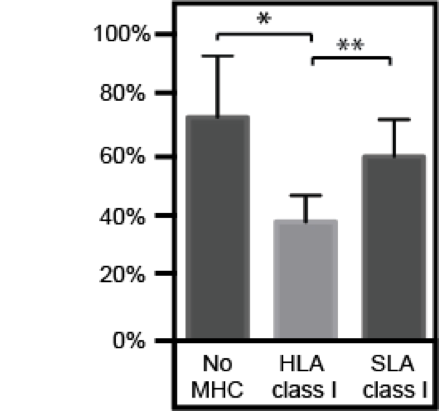A Swine for Human MHC Class I Swap: Implications for Xenotransplantation.
1Transplant Surgery, University of Alabama-Birmingham, Birmingham, AL
2Surgery, Indiana University, Indianapolis, IN
Meeting: 2017 American Transplant Congress
Abstract number: B303
Keywords: MHC class I, Pig, Xenoreactive antibodies, Xenotransplantation
Session Information
Session Name: Poster Session B: Xenotransplantation
Session Type: Poster Session
Date: Sunday, April 30, 2017
Session Time: 6:00pm-7:00pm
 Presentation Time: 6:00pm-7:00pm
Presentation Time: 6:00pm-7:00pm
Location: Hall D1
Background: Xenotransplantation is a potential supply-side solution to the growing need for life-saving transplantable organs, but it was not until the recent advances in genetic engineering that rapid manipulation became an obtainable goal. It is the goal of this study to examine the effect of replacing SLA class I with HLA class I in swine aortic endothelial cells (AECs) and to determine if this swap will be beneficial for future xenografts.
Methods: Two CRISPR gRNA plasmids were designed to remove the entire coding sequence of SLA class I and co-transfected with a third plasmid, a promoterless Hygromycin resistance gene surrounded by PhiC31 recombinase sequences, followed with promoterless HLA-A2 cDNA. The response of HLA-A2 sensitized and non-sensitized individuals to the HLA-A2 positive vs a SLA class I positive cells was evaluated in a flow cytometry crossmatch (FCXM) and a mixed lymphocyte reaction (MLR).
Results: The HLA-A2 expressing cell line was successfully generated as described above. A two-way paired t-test revealed statistically significant IgG antibody binding to the parent vs the HLA-A2 swap AEC in both those with known class I non-HLA-A2 sensitization (1A, p < 0.0001) and known HLA-A2 sensitization (1B, p = 0.0010). For IgM, significance was found in those with known HLA-A2 sensitization (1D, p = 0.0377) but not with known class I non-HLA-A2 sensitization (1C, p = 0.8931). The results of the MLR showed less proliferation to the HLA-A2 positive cell line compared to the MHC-null parent and a SLA class I positive cell line
The results of the MLR showed less proliferation to the HLA-A2 positive cell line compared to the MHC-null parent and a SLA class I positive cell line  (p = 0.0017 and p = 0.0006, respectively).
(p = 0.0017 and p = 0.0006, respectively).
Conclusions: This study demonstrates that a MHC swap will be the next step in personalized xenograft organs.
CITATION INFORMATION: Ladowski J, Santos R, Reyes L, Martens G, Butler J, Sidner R, Wang Z.-Y, Cunningham C, Tector M, Tector A. A Swine for Human MHC Class I Swap: Implications for Xenotransplantation. Am J Transplant. 2017;17 (suppl 3).
To cite this abstract in AMA style:
Ladowski J, Santos R, Reyes L, Martens G, Butler J, Sidner R, Wang Z-Y, Cunningham C, Tector M, Tector A. A Swine for Human MHC Class I Swap: Implications for Xenotransplantation. [abstract]. Am J Transplant. 2017; 17 (suppl 3). https://atcmeetingabstracts.com/abstract/a-swine-for-human-mhc-class-i-swap-implications-for-xenotransplantation/. Accessed December 27, 2025.« Back to 2017 American Transplant Congress
